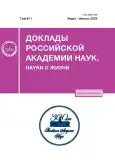EARLY POSTNATAL EXPERIENCE MODIFIES ACTIVATION OF THE PITUITARY-TESTICULAR COMPLEX IN MALE HOUSE MICE (MUS MUSCULUS) EXPOSED TO THE ODOR OF RECEPTIVE CON- AND HETEROSPECIFIC FEMALES
- Авторлар: Kotenkova E.V.1, Kuznezova E.V.1, Maltsev A.N.1, Ambaryan A.V.1
-
Мекемелер:
- Severtsov Institute of Problems of Ecology and Evolution, Russian Academy of Sciences
- Шығарылым: Том 511, № 1 (2023)
- Беттер: 381-386
- Бөлім: Articles
- URL: https://journals.rcsi.science/2686-7389/article/view/135655
- DOI: https://doi.org/10.31857/S2686738923700294
- EDN: https://elibrary.ru/IRVGCN
- ID: 135655
Дәйексөз келтіру
Толық мәтін
Аннотация
For the first time, data were obtained proving the modification of the activation of the pituitary-testicular complex of male house mice under the influence of early postnatal experience and the maternal environment when exposed to the odor of receptive females of their own and closely related species. We have confirmed the conjugacy of the formation of behavioral and physiological mechanisms of precopulatory isolation in early ontogenesis. The serum level of free testosterone in males of closely related species M. spicilegus and M. m. wagneri differ, it is significantly lower in mound-building mice. The level of free testosterone of males fostered by a conspecific female was significantly lower when they exposed a heterospecific in comparison with a conspecific female odor. The rearing of M. m. wagneri males by females of a closely related species caused a decrease in the testosterone response of males to the exposure of chemosignals from a female (both con-and heterospecific) and led to the absence of differences in the serum level of free testosterone when they exposed to the odor of a female of their own or closely related species. The data obtained indicate a significant influence of the rearing conditions on the formation of hormonal mechanisms of reproductive isolation.
Негізгі сөздер
Авторлар туралы
E. Kotenkova
Severtsov Institute of Problems of Ecology and Evolution, Russian Academy of Sciences
Хат алмасуға жауапты Автор.
Email: evkotenkova@yandex.ru
Russian Federation, Moscow
E. Kuznezova
Severtsov Institute of Problems of Ecology and Evolution, Russian Academy of Sciences
Email: evkotenkova@yandex.ru
Russian Federation, Moscow
A. Maltsev
Severtsov Institute of Problems of Ecology and Evolution, Russian Academy of Sciences
Email: evkotenkova@yandex.ru
Russian Federation, Moscow
A. Ambaryan
Severtsov Institute of Problems of Ecology and Evolution, Russian Academy of Sciences
Email: evkotenkova@yandex.ru
Russian Federation, Moscow
Әдебиет тізімі
- Котенкова Е.В., Мальцев А.Н., Амбарян А.В. Влияние раннего обонятельного опыта на выбор полового партнера у млекопитающих: эволюционные аспекты // Журнал общей биологии. 2017. Т. 78. № 4. С. 21–39.
- Soini H.A., Wiesler D., Koyama S. et al. Comparison of urinary scents of two related mouse species, Mus spicilegus and Mus domesticus // Journal of Chemical Ecology. 2009. V. 35. № 5. P. 580–589.
- Mucignat-Caretta C., Redaelli M.L. et al. Urinary volatile molecules vary in males of the two European subspecies of the house mouse and their hybrids // Chemical Senses. 2010. V. 35. № 8. P. 647–654.
- Котенкова Е.В. Сравнительный анализ этологических и физиологических механизмов прекопуляционной репродуктивной изоляции у грызунов // Успехи современной биологии. 2014. Т. 135. № 5. С. 488–518.
- Macrides F., Bartke A., Dalterio S. Strange females increase plasma testosterone levels in male mice // Science. 1975. V. 189. № 4208. P. 1104–1106.
- Осадчук А.В. Микроэволюционные основы функционирования адренокортикальной и половой систем. В кн.: Онтогенетические и генетико-эволюционные аспекты нейроэндокринной регуляции стресса. Новосибирск: “Наука”. 1990. С. 160–170.
- Амстиславская Т.Г., Осипов К.В. Половая активация самцов крыс: поведение и гормональный ответ // Бюллетень СО РАМН. 2003. Т. 109. № 3. С. 112–114.
- Феоктистова Н.Ю., Кропоткина М.В., Поташникова Е.В. и др. Видообразование у аллопатрических видов хомячков подсемейства Cricetinae (Rodentia, Cricetidae) // Журнал общей биологии. 2018. Т. 79. № 4. С. 262–276.
- Kotenkova E.V., Osadchuck A.V., Lyalyukhina S.I. Precopulatory isolating mechanisms between the house and mound-building mouse// Acta Theriologica. 1989. V. 34. № 22. P. 315–324.
- Maras P.M., Petrulis A. Olfactory experience and the development of odor preference and vaginal marking in female Syrian hamsters // Physiology and Behavior. 2008. V. 94. № 4. P. 545–551.
- Kotenkova E., Romachenko A., Ambaryan A., Maltsev A. Effect of early experience on neuronal and behavioral responses to con- and heterospecific odors in closely related Mus taxa: epigenetic contribution in formation of precopulatory isolation // BMC Evolutionary Biology. 2019. 19 (Suppl 1): 51.
- Cheal M. Social olfaction: A review of the ontogeny of olfactory influences on vertebrate behavior // Behavioral Biology. 1975. V. 15. № 1. P. 1–25.
- Parasuraman S., Raveendran R., Kesavan R. Blood sample collection in small laboratory animals // Journal of Pharmacology and Pharmacotherapeutics. 2010. V. 1. № 2. P. 87–93.
- Patris B., Gouat P., Jacquot C., Christophe N., and Baudoin C. Agonistic and sociable behaviors in the mound-building mouse, Mus spicilegus, a comparative study with Mus musculus domesticus // Aggressive Behavior. 2002. V. 28. № 1. P. 75–84.
Қосымша файлдар









